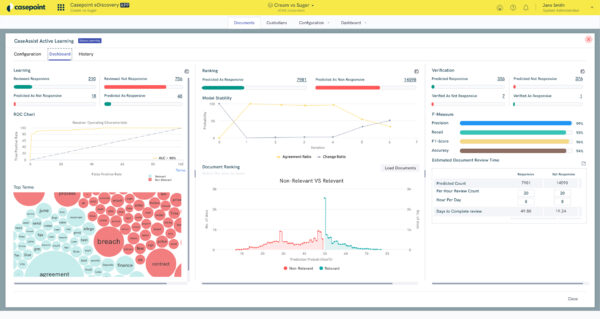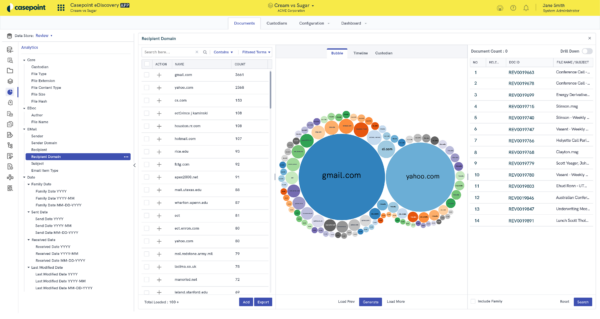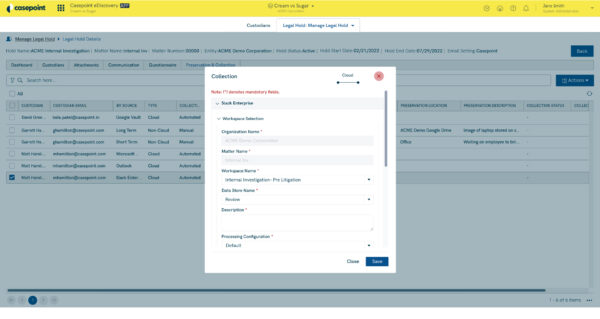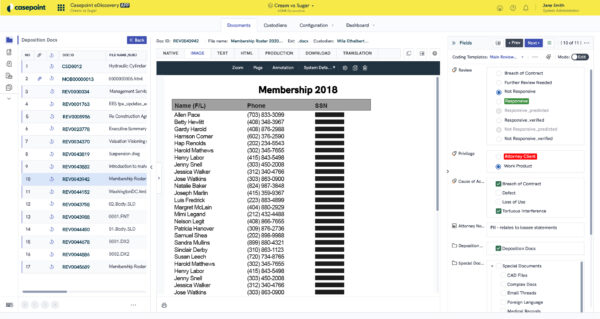Casepoint entered the cloud eDiscovery platform market in 2008. I had always classified it as a firm focused large matter boutique hosting platform based on their good reputation and minimal marketing presence. David Carns and Athena Strasel updated me on Casepoint’s changing role and architecture in before and after the Pandemic pause. Casepoint’s successful bid to replace Recommind as the SEC’s primary eDiscovery platform seems to have opened the door for wider government and corporate long-term relationships. Navigating the FedRAMP compliance gives customers confidence in a company’s security and stability.
 David Carns: That was when the whole thing took off. Over the past couple of years our corporate practice has really matured. Yes, we started as a good law firm doc review, processing engine, all integrated SAS tool, blah blah blah. Through a security route we’ve become an enterprise class eDiscovery platform. We may have started in the litigation department, but now are being used by internal investigations and more. HR and the compliance group realize we have tools to identify PII and all of a sudden we are supporting their data breach response.
David Carns: That was when the whole thing took off. Over the past couple of years our corporate practice has really matured. Yes, we started as a good law firm doc review, processing engine, all integrated SAS tool, blah blah blah. Through a security route we’ve become an enterprise class eDiscovery platform. We may have started in the litigation department, but now are being used by internal investigations and more. HR and the compliance group realize we have tools to identify PII and all of a sudden we are supporting their data breach response.
Casepoint’s cloud collection from Google, Dropbox and others was driven by client collection requests. Enabling OAUTH and direct client driven collections kept Casepoint from holding custodian credentials.
 David Carns: Casepoint has an amazing processing engine, ECA tools, active learning review and complex production capabilities. We expanded the cloud collections and added a nascent legal hold to bolster our eDiscovery lifecycle story. All of a sudden we’re being used across multiple matters by large corporations demanding multi-matter management functionality.
David Carns: Casepoint has an amazing processing engine, ECA tools, active learning review and complex production capabilities. We expanded the cloud collections and added a nascent legal hold to bolster our eDiscovery lifecycle story. All of a sudden we’re being used across multiple matters by large corporations demanding multi-matter management functionality.
I have been pitching and tracking the value to corporations taking ownership of their eDiscovery and leveraging centralized collections, holds and work product.
David Carns: COVID hit and everyone in the world moved to Microsoft 365, Slack or Google Workspace because everybody had to get everything online as quickly as possible. They wanted to reuse custodian data and Priv tags between matters. The ability to search across all of their matters at the same time was a game changer.
Casepoint’s announcement of portable predictive AI models caught my attention. Moving AI models between cases and systems frequently requires expert support as we covered in my recent Redgrave Data briefing.
David Carns: The multi model approach makes a lot of sense for corporate customers. They are totally fine with their data being used to train a model and then that model being applied to some more of their data. Obviously no one is going to buy in on using Corporation A’s trained model on Corporation B’s data.
Interestingly enough, that is exactly what Microsoft is doing with their sensitivity classifiers, even if most customers have not read that part of the M365 EULA agreements. Who reads those anyway? David and Athena went on to discuss the maturation of the industry and how Casepoint has been moving left as corporations expand their usage scenarios and become more comfortable with self-service workflows. All of this required a major rearchitecture to support.
 David Carns: We rebuilt our Casepoint from the ground up over three years. It was a complete rewrite rather than a simple back end rearchitecture. We released the new version in 2019 to support customer demand for true self-service. We don’t want to pay you to do this on an hourly basis. We want to do it ourselves. We want to process our own data. We want to deal with our own exceptions. So yes, Casepoint in now is completely self-service except for when people don’t want it to be.
David Carns: We rebuilt our Casepoint from the ground up over three years. It was a complete rewrite rather than a simple back end rearchitecture. We released the new version in 2019 to support customer demand for true self-service. We don’t want to pay you to do this on an hourly basis. We want to do it ourselves. We want to process our own data. We want to deal with our own exceptions. So yes, Casepoint in now is completely self-service except for when people don’t want it to be.
Self-service platforms carry the connotation of being rigid and forcing customers into a defined workflow. As several peers have remarked recently, ‘everything in eDiscovery is an exception’. So I asked how the new Casepoint solution appeals to customers with custom requirements.
 David Carns: For better or worse, Casepoint is not an 80/20 company. We are more of a 96/4% company. We try to solve for all of the edge cases while providing out-of-the-box templates and workflow for customers who just want drag and drop simplicity to take data from collection to review.
David Carns: For better or worse, Casepoint is not an 80/20 company. We are more of a 96/4% company. We try to solve for all of the edge cases while providing out-of-the-box templates and workflow for customers who just want drag and drop simplicity to take data from collection to review.
Overall I am happy that Carolyn Depko at Plat4orm PR reached out for a Casepoint briefing. It was a good reminder that product profiles, customer requirements and the eDiscovery marketspace are all constantly evolving. Casepoint might not have made my RFP contender list for corporate clients in the past, but it will now. Are you a Casepoint customer who would like to share your experience anonymously? Feel free to send me your thoughts and comments.
 Greg Buckles wants your feedback, questions or project inquiries at Greg@eDJGroupInc.com. Contact him directly for a free 15 minute ‘Good Karma’ call. He solves problems and creates eDiscovery solutions for enterprise and law firm clients.
Greg Buckles wants your feedback, questions or project inquiries at Greg@eDJGroupInc.com. Contact him directly for a free 15 minute ‘Good Karma’ call. He solves problems and creates eDiscovery solutions for enterprise and law firm clients.
Greg’s blog perspectives are personal opinions and should not be interpreted as a professional judgment or advice. Greg is no longer a journalist and all perspectives are based on best public information. Blog content is neither approved nor reviewed by any providers prior to being published. Do you want to share your own perspective? Greg is looking for practical, professional informative perspectives free of marketing fluff, hidden agendas or personal/product bias. Outside blogs will clearly indicate the author, company and any relevant affiliations.
See Greg’s latest pic on Instagram.
